Made in the shade
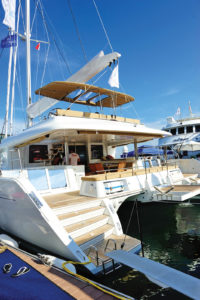
In the recent past, innovative fabricators have created more flexible shade structures to allow boaters to enjoy their time in the sun with less risk to the dangers of overexposure, yet still maintaining flexibility of open-air cruising.
A decade ago, shading on boats was relegated to permanent or semi-permanent structures. Marine fabricators, however, started to experiment with removable shade structures, and boaters got on board.
“With all the concern about sun exposure and skin cancer, shade tops have really come to the forefront of people’s minds,” says Keith Purves of Riverside Covers in Fort Myers, Fla. “There are lifelong boaters who know they need more protection from the sun.”
Combine these concerns with a desire to relax on the boat away from the blazing sun, and shade systems have evolved from nice-to-have options to must-haves.
Innovative shade solutions
Shade structures fall into three categories: fixed, collapsible, and temporary. An example of a fixed structure is a laceless T-top for fishing and center-console boats, which Purves has been fabricating for about five years. Not only do the tops—typically made of a heavy double-coated vinyl—offer protecting shade, but they “give the boat an ultra-clean, high-end appearance, and make them look very similar to a fiberglass hardtop,” he says.
Purves also has built brows, a type of shade top that attaches to the boat’s existing arch or hardtop, which serves as part of the support structure. These shades differ from biminis in that brows usually do not fold up for storage. “A typical brow is made with one or two stainless-steel bows and has minimal support legs that angle back to the arch or hard top,” he explains. “The canvas is slid into a track, which is fastened to the arch, and attaches to the stainless-steel bows with a zippered pocket.”
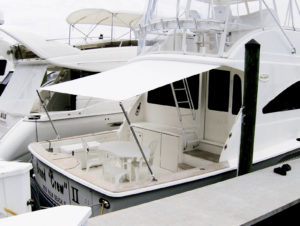
Temporary shading systems are designed for easy deployment, and do not require additional hardware on the boat.
On a few occasions, Mark Hood, owner of Hood Marine Canvas in Merrimac, Mass., has created permanent awnings that extend from the aft end of any hardtop to provide shade and protection from the elements. This helps to reduce heating of the cabin by the sun’s rays. “The awnings can cover from three feet to 20 feet or more, and they sometimes have a hole cut in them so people can climb the ladder to the bridge,” he notes.
Collapsible tops, like biminis, have hinges that fold down for storage. They’re not usually removed from the boat, Purves notes, but they can be unzipped for cleaning or re-applying a waterproof coating.
Meanwhile, temporary shading systems are designed for easy deployment. Mike Erickson, owner of Canvas Designers in Riviera Beach, Fla., fabricates a product he calls a sun fly, which, at its most basic level, entails a rectangular-shaped piece of canvas tensioned out from a forward-topper hard top using two poles that drop into rod holders. The temporary structure does not require additional hardware on the boat.
Erickson, whose shop has been producing sun flies for 10 years, notes increasing popularity of the product as more people see it in action. “Customers might request a traditional bimini, but we tell them that the shade fly goes up and comes down in a couple of minutes. There aren’t a bunch of frames getting in your way or messing with your fishing capabilities.”
Over the past decade, the sun fly has become more elaborate when the boat calls for it. Erickson attributes this shift to MPanel software, which allows for the creation of different shapes and overlapping multiple shades, not to mention more precise design. “We can design things ahead of time instead of having to take physical patterns, triangulate them, and then design it in CAD,” he notes.
Creating the appropriate structure
“The type of shade system comes down to how people use their boat,” Hood says. For example, he cites boaters who use their craft as a weekend condo and want protection from the sun—not to mention from bugs and inclement weather.
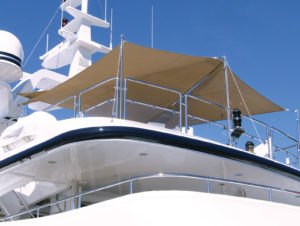
Fabricators take into account a number of factors when crafting shade structures. For example, fabric choice plays an important role in the creation of shade structures. The biggest mistake fabricators make when building shades structures is underestimating the amount of tension that will be cantilevered on a pole.
In such instances, Hood will fabricate a camper back top, which extends shade and weather protection to the stern of the boat. The forward top and aft camper top are connected with a zipper and constructed to appear as one continuous top. Sometimes Hood will create two sets of removable panels. One is made of clear vinyl to defend against those rainy, windy days; the other set often is constructed with a durable vinyl-coated polyester mesh designed to keep the sun’s rays out while allowing ventilation into the space. Marine-grade canvas tops the structure.
Hood also has used the mesh fabric as an alternative to a solid cover on the windshields of fishing boats. “The sun streams through these windshields and heats up the cabin,” he says. “The mesh protects from a lot of that sun coming through while still providing some degree of visibility.”
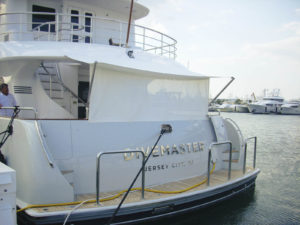 Riverside Covers makes it clear to customers that the shade flies they produce are for temporary use only. “I specifically state that the shade fly is not intended for when the boat is underway at speeds,” Purves says, adding that he uses the lightest-weight fabric available to build these systems. “It can be used while the boat is anchored and you are eating lunch, or even if you’re on a slow ride.”
Riverside Covers makes it clear to customers that the shade flies they produce are for temporary use only. “I specifically state that the shade fly is not intended for when the boat is underway at speeds,” Purves says, adding that he uses the lightest-weight fabric available to build these systems. “It can be used while the boat is anchored and you are eating lunch, or even if you’re on a slow ride.”
Hood has started installing a product called an awning strut, manufactured by Performance Textiles. “Some people like to have sun protection at the aft end of the boat, but they don’t want the big framework within the enclosure that they have to store somewhere,” he says. “With the awning strut, special sockets are anchored into the boat’s deck. Poles are placed into sockets and feature a pulley system and a cleat. The system is very rigid and can angle out. A piece of canvas is tensioned by these poles and pulls out to offer shade without a large framework involved.” The poles release from the deck mounts and can be easily stored.
Alternatively, an aft deck awning uses a single stainless steel frame bow, which has to be stored when not in use. “We usually sleeve these single bows so they can break apart in the center, but it’s a little awkward to set up and stow,” Hood notes. “The awning strut is much more convenient, but at a higher cost for the struts.”
Make the right call
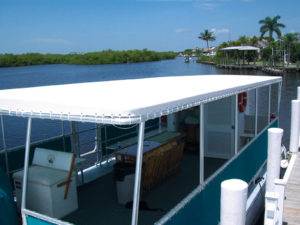
From permanent vessel-length covers, to roll-up screens, fabricators such as Riverside Covers of Fort Myers, Fla., can create shading systems to meet nearly any boater’s wishes.
Fabricators take into account a number of factors when crafting shade structures. For example, fabric choice plays an important role in the creation of shade structures. “You have to be careful to watch your pitch and what fabric you’re using, because if you’re using a solid fabric, you’ll just have a big bowl that holds water,” Erickson says. “You can avoid this problem by using a dimensionally stable mesh shade.”
Additionally, Erickson notes the biggest mistake fabricators make when building shade structures is underestimating the amount of tension that will be cantilevered on a pole. A simple sun fly structure uses poles that drop into existing rod holders and thus doesn’t require extra hardware. “But when you take a six-foot pole and go out six feet and pull the tension on the end of it, that puts a lot of leverage on it. You’ve got to be really careful with your rigging.”
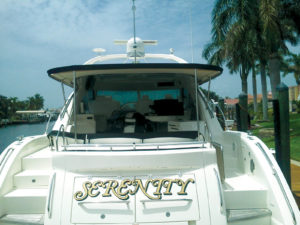 Purves tries to “overbuild” the shade structure by exceeding the limitations of the boat. “A customer may say, ‘I don’t go that fast when I have the bimini open,’ but I know from being a boater that there are circumstances like strong winds that are out of your control,” he notes.
Purves tries to “overbuild” the shade structure by exceeding the limitations of the boat. “A customer may say, ‘I don’t go that fast when I have the bimini open,’ but I know from being a boater that there are circumstances like strong winds that are out of your control,” he notes.
Furthermore, Purves approaches his jobs with both the boat and boater in mind. “I consider ease of use and practicality,” he explains. “Longevity is another thing I try to promote, so I do everything I can to make my canvas last as long as possible. Then, of course, there are aesthetics. It’s important to make it look like the boat was designed around the canvas, and not the other way around.”
If a canvas shop does not have the resources to complete a project, Erickson suggests the fabricator partner with another shop. Case in point: Erickson worked with Terri Madden of Sand Sea and Air Interiors Inc. of San Juan, Puerto Rico, to create a structure comprising five shades.
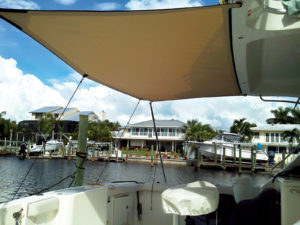
Shading systems might be as uncomplicated as a simple fabric extension from a boat’s permanent hard top, but most fabricators design such ” add ons” to appear as if they were original equipment.
“She sent me all the triangulated measurements, we ran them through CAD, and we fabricated and shipped overlapping shade sails to her,” he recalls. “Sometimes collaborating on projects can be a win-win if you don’t have certain in-house capabilities.”
Holly O’Dell is a freelance writer from Pine City, Minn.
 TEXTILES.ORG
TEXTILES.ORG 






